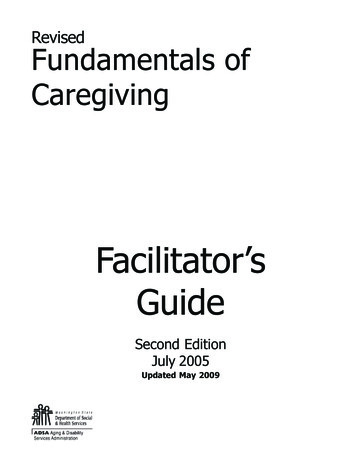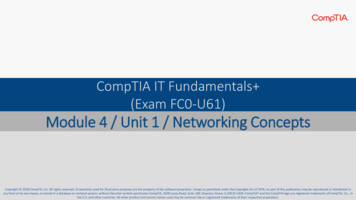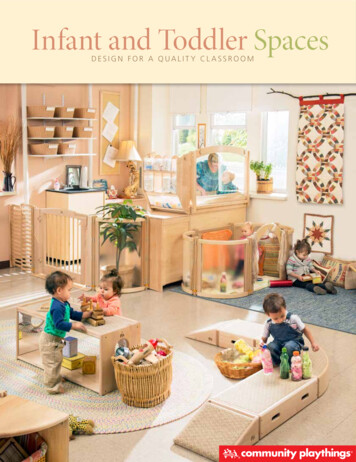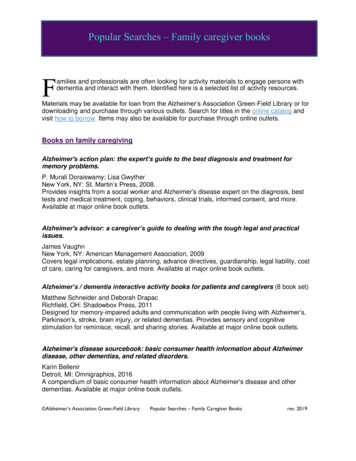
Transcription
RevisedFundamentals ofCaregivingFacilitator’sGuideSecond EditionJuly 2005Updated May 2009
Using the Facilitator’s GuideYour Facilitator’s Guide has instructions for teaching the course. Review the materialthoroughly and become familiar with the Learners Guide, the Resource Directory, the CommonDiseases and Conditions sections, the course techniques, and exercises prior to teaching thecourse.Facilitator’s Guide set-upYour Facilitator’s Guide has been formatted with the Learner’s Guide page appearing on the left.The right-hand side the page is for additional instructions on how to teach the Learner’s Guidepage, if any are needed. Page numbers for the Facilitator’s Guide appear only on the righthand page.The exception to this formatting rule is when several Learner’s Guide pages appearconsecutively with no instructor’s notes needed. In these cases, another Learner’s Guide pagealso appears on the right-hand side of the page.Course OverviewThe content of the Revised Fundamentals of Caregiving curriculum is based on the requiredknowledge and skills outlined for basic caregiver training in WAC 388-112-0055.The WAC defines the following core knowledge and skills. The caregiver will be able to:yunderstand and use effective interpersonal and problem solving skills with the resident,family members and other care team members;ytake appropriate action to promote and protect resident rights, dignity, and independence;ytake appropriate action to promote and protect the health and safety of the resident andthe caregiver;ycorrectly perform required personal care tasks while incorporating resident preferences,maintaining the resident's privacy and dignity, and creating opportunities that encourageresident independence;yadhere to basic job standards and expectations.Course ScheduleClassroom timesTimes allocated above for each module are guidelines. Some amount of variation isexpected due to things such as class size or the number of questions a class mayhave on a particular subject. See the Facilitator Guide for specifics of how much timehas been allocated for Module Reviews, Module Scenarios, and required exercises.Course Structure and TeachingRevised Fundamentals of CaregivingTechniquesPage Intro-1
Course ScheduleDAY 1TimeModule 1 – Course IntroductionModule 2Lesson 1 - The ClientLesson 2 - Client RightsModule 3 – The CaregiverModule 4Lesson 1 – Infection Control30 Min.15 Min.2 Hours 35 Min.1 Hour 40 Min.DAY 2TimeModule 4Lesson 2 – Blood Borne PathogensModule 5 – MobilityModule 6 – Basic CommunicationModule 7Lesson 1 – Skin CareLesson 2 – Body Care1 Hour 10 Min.2 Hours 5 Min.45 Min.SkillsBody MechanicsTransferHelping a Client WalkTurn and Reposition a Client in Bed1 Hour 35 Min.1 Hour 25 Min.TimeModule 7 (continued)Lesson 2 – Body Care - ContinuedModule 8Lesson 1 - NutritionLesson 2 – Food HandlingModule 9 – The Process of Elimination2 Hours 40 Min.DAY 4TimeRevised Fundamentals of CaregivingPage Intro-2Hand WashingPutting On and Taking Off Gloves2 HoursDAY 3Module 10Lesson 1 – Self Directed Care and NurseDelegationLesson 2 – MedicationsModule 11Lesson 1 – Self Care and the CaregiverLesson 2 – Grief and LossTest ReviewWritten ExamSkill Demonstration TestingSkills1 Hour 30 Min.45 Min.2 Hours 5 Min.SkillsMouth CareClean and Store DenturesA Shave with Safety RazorFingernail CareFoot CareBed BathAssist Client with Weak Arm toDressPut Knee-High Stocking on ClientPassive Range of MotionAssist a Client to EatAssist Client with PericareAssist Client with Use of BedpanCatheter CareAssist Client with Condom CatheterCareSkillAssisting with Medications20 Min.1 Hour 30 Min.1 Hour 30 Min.20 Min.20 Min.1 Hour2 HoursCourse Structure and Teaching Techniques
Course StructureOverviewThe course structure is developed around six key elements, including:1. Learner’s Guide content and activities;2. Skill demonstrations;3. Skill stations;4. DOC teams;5. Module Reviews; and6. Module Scenarios.1. The Learner’s Guide is the student’s textbook and includes all of the course content andactivities.2. Skills demonstrations give students a clear, visual, step-by-step demonstration of theproper procedure for completing a skill.3. Skill stations are practice areas set up in the classroom where all the needed supplies toperform a personal care task have been gathered and are available for students to practiceskills.4. DOC Teams (doer, observer, client) give students the opportunity to take turns practicingthe skill, experiencing what it is like to be the recipient of care, and practicing observationskills and peer teaching with other students. DOC teams are used with skill stations, ModuleScenarios, study teams, and during skills demonstration testing at the end of the course.5. Module Reviews are practice quizzes at the end of each module. Module Reviewsreinforce the major points in the module, lets the instructors know if students understandthe materials, and gives the instructor the opportunity to clarify or review particular topics.Module Reviews also ease test anxiety as students become familiar with the testing formatand feel better prepared to take the written test.6. Module scenarios reinforce and give students practice in:y problem solving in common caregiving situations;y understanding how caregiving is impacted by a client’s disease and/or condition;y performing the selected skill correctly while demonstrating respectful communicationand attention to client rights.Module Scenarios are mandatory and are completed after the Module Reviews in Modules5, 7 (after lessons one and two), 9, and 10.Course Structure and TeachingRevised Fundamentals of CaregivingTechniquesPage Intro-3
Working with students1. Learner’s Guide content and activitiesIt is expected that the content on the Learner’s Guide page will be covered with the students.How much depth to cover in each section varies.Highlighted material in the Facilitator’s Guide must be covered thoroughly. For non-highlightedmaterial, follow any specific instructions found on the right-hand page. If no further instructionis given, summarize the main points of the section for students.2. Skill demonstrationsDemonstrating skills is more than just “showing” students how to do something. Teaching anew skill requires a well thought out process that includes an overview of the skill,demonstrating the skill, reviewing the skill with a student volunteer, and time for students topractice. Step 1: Introduce the skillGive a clear and brief overview of the task or skill you will demonstrate. Build a bridge forthe students so they understand why it is important that they know how to perform the skillcorrectly. Step 2: Tell them how.Go through each step in the proper sequence, demonstrating and explaining the mechanicsof each step. This allows the student to see the steps from start to finish and gives them agood visual of the entire procedure. Make sure all students can see the skill beingdemonstrated. Step 3: Review.Ask for a volunteer to demonstrate how to do the new skill or task in front of the group.Before beginning, review the steps once again. This process helps students see commonmistakes made when first beginning to learn the skill. It also reinforces that it isn’t as easyas it looks to do it yourself. Step 4: Practice.Allow students to practice in skill stations.3. Skill stationsSetting up skill stationsA bed, chair, hand washing facility, wheelchair, mannequin, and other supplies for teaching allof the personal care tasks must be in the classroom.The supplies needed for each skill station will change depending on which skills are taught andpracticed during that portion of the day. Set skill stations up prior to students needing to usethem.Skill stations should be set up so DOC teams can rotate through different stations during skillspractice. For example, supplies for mouth care, denture care, and shaving may be at onestation with foot care, fingernail care, and bed bath at another station. This helps reduce theamount of supplies required (though for larger classes you likely need more than one skillstation with the same equipment) and helps keep the DOC teams focused.Revised Fundamentals of CaregivingPage Intro-4Course Structure and Teaching Techniques
How many skills you wish to demonstrate before you have the students practice in skill stationsis left to your discretion. Keep in mind, students can only retain so much new information atone time. It is recommended that you demonstrate several skills and then allow students topractice.Students need to practice soon after a skill demonstration. It is recommended that you notdemonstrate a skill at the end of one day without allowing students to practice that skill beforethey go home.4. DOC TeamsA DOC team is comprised of three students with distinct roles.yD-Doer - The person who takes the role of the caregiver and performs the selected caretask.yO-Observer – The person who observes, helps make sure tasks are done correctly, andoffers feedback to the doer.Note: Besides making sure the doer performs the physical aspects of the skill correctly, theobserver should be instructed to watch for and provide feedback on thecommunication/client rights skills noted at the bottom of each Skills Demonstration Checklist(found at the back of the Learner’s Guide starting on page 326).yC-Client – The person who takes the role of the client.Setting up DOC teamsAssign students to the DOC team. It is recommended that you do not put more than onelimited English speaking person in each DOC team. Don’t put people who know each other welltogether.When first introducing the DOC teams to students, explain the different roles and why they arebeing used during the course. Explain each DOC team member must practice each role. Rolesshould not be switched until each Doer has successfully completed the assigned skill.Instructor role during skills practiceYour role during the skills station practice time is to monitor the students and make sure:y students are performing the skills correctly;y the groups stay focused;y each team member takes on each role; andy questions are answered.5. Module ReviewsExplain to students that Module Reviews are completed individually. Students should treat theModule Review as a “quiz” – although they will not be turned in and graded.Give students a timeline for completing each Module Review (noted in the Facilitator’s Guide).If the majority of students are done at the end of the allotted time, review the answers. You donot have to wait for every student to complete the review before proceeding. Make sure eachstudent participates.Watch to see which students may be struggling (see ESL notes on next page). This lets youknow who might need extra help during the class and perhaps during the written test.Course Structure and TeachingRevised Fundamentals of CaregivingTechniquesPage Intro-5
Instructor option: You may choose to let the students do the Module Reviews as an “openbook”. If you do so, tell the students to do as much as they can from memory before openingtheir Learner’s Guide. Let them know the final written test will not be open book.ESL and low literacy learnersPair students up and have one student read questions out loud to the other student or havestudents work together in their DOC teams. If a translator is available, have the translator readthe questions to the student.Remind students that the final written test can be read to them if that would be helpful.Processing the Lesson ReviewOnce the majority of students have finished, go through each question and ask for a volunteerto report his/her answer. Make sure the answers are correct. Have students correct anyincorrect answers in their own Learner’s Guide.Allow time for questions or clarification of incorrect answers. If students appear confused aboutany of the content, review that topic in more depth before moving on to the next Module.6. Module ScenariosCompleting the “Research” and “Problem Solve” stepsGroup the students in their DOC teams. Instruct students to:y read through the module scenario;y review the highlighted disease(s) in the Common Diseases and Conditions section; andy work through the specific steps called out in “Problem Solve”.Remind students there may be more than one problem within the scenario and there is not“one” right answer.Completing the “Demonstrate” skillOnce the research and problem solving steps are completed, have students practice the skillwith their DOC team.Group Discussion on the Problem SolvingAsk the groups to identify what problem they selected to focus on, the solution they picked, andwhy.This normally generates a lively discussion – which is also an important learning experience forstudents. It helps reinforce that there are always a variety of factors influencing what ishappening with a client, different perceptions of “what” the problem is, and many ways to solvesimilar situations.Large group skill demonstration (by one team)Select one group or ask for one team to volunteer to demonstrate the skill.Give the assigned team a minute to choose who will demonstrate. They should then performthe assigned demonstration in front of the class.Revised Fundamentals of CaregivingPage Intro-6Course Structure and Teaching Techniques
Teaching techniquesAdult learners learn best from a blend of approaches that appeal to a variety of learning styles.RFOC uses a variety of techniques designed for adult learners to enhance student learning,participation, and to stimulate interaction.The following is a brief description of the methods and techniques used throughout the course.The Facilitator’s Guide uses these icons to alert you to the recommended technique for thatparticular section.Instructor note: provides added information/expectations.Lectures highlight key points and provide information so student’s can graspthe content.Skills demonstrations give students a clear, visual, step-by-step sequenceof the proper procedure for completing a skill.Exercises give students an opportunity to take a more in-depth look atspecific topics.Exercises documented in the Facilitator’s Guide are mandatory and should betaught as documented.Optional ExercisesOptional exercises have been included in the Facilitator’s Guide and can beused or modified (if time permits) to reinforce key points in the module.Optional exercises do not replace the mandatory exercises.OptionalGuided Discussions allow the instructor to lead the class in the discussion of atopic while assuring there is structure and order to how the discussion evolves.Discussions are developed by using planned questions or statements. Guideddiscussions provide the opportunity for all students to participate in the exchangeof ideas.Brainstorming is a tool that encourages spontaneous, uninhibited thought. Itenables students to look at old familiar situations and see new perspectives.Course Structure and TeachingRevised Fundamentals of CaregivingTechniquesPage Intro-7
RevisedFundamentals ofCaregivingLearner’sGuideSecond EditionJuly 2005Updated May 2009
Table of ContentsRevised Fundamentals of CaregivingModule 1 – Course IntroductionLesson 1Successfully Completing the CourseGround RulesLearning StylesPage366Module 2 – The Client and Client RightsLesson 1The Client12Lesson 2Client RightsFreedom of choiceConfidentialityA Client’s Right to Make Health Care DecisionsAdvance DirectivesLong-Term Care Ombudsman ProgramAbuseMandatory ReportingRestraintsEffective Problem SolvingModule Review1718191920222327303335Module 3 – The CaregiverLesson 1The CaregiverBasic Job ResponsibilitiesProviding Personal CareRespecting a Client’s Privacy and IndependenceHonoring DifferencesCaregiver as Part of a Care TeamDocumenting ObservationsReportingReporting GuidelinesProfessional ConductProfessional BoundariesCaregiving as a Professional JobResponding to Situations and EmergenciesSafety Habits that Prevent AccidentsHandling EmergenciesModule Review39394043454648495050515254545456Module 4 – Infection ControlLesson 1Infections and How They SpreadInfection ControlHandwashingSkill: Hand WashingWearing glovesSkill: Putting On and Taking Off GlovesTable of ContentsPage i-1606262636566
Cleaning and DisinfectingImmunizationsObserving and Reporting if a Client has an InfectionPage686869Lesson 2More About Blood Borne PathogensStandard PrecautionsHIV/AIDSModule Review71727581Module 5 – MobilityLesson 1Body MechanicsMobilityTransfersSkill: Transfer Client from Bed to Chair/WheelchairHelping a Client WalkSkill: Helping a Client WalkFallsFall PreventionModule Review858586868989919294Module 6 – Basic CommunicationLesson 1Managing Your CommunicationBody LanguageMaking Sure Your Message Has Been UnderstoodActive ListeningBarriers to Effective CommunicationManaging Challenging CommunicationModule Review9797100103104106108Module 7 – Skin and Body CareLesson 1Skin CarePromoting Healthy Skin CarePressure UlcersChanging a Client’s PositionSkill: Turn and Reposition a Client in BedLesson 2Personal HygieneSkill: Mouth CareSkill: Clean and Store DenturesSkill: A Shave with Safety RazorSkill: Fingernail CareSkill: Foot CareSkill: Bed BathSkill: Assisting a Client to DressSkill: Assist Client with Weak Arm to DressSkill: Put Knee-High Stocking on ClientSkill: Passive Range of Motion for One ShoulderSkill: Passive Range of Motion for One Knee and AnkleModule 9130130131Table of ContentsPage i-2
Module 8 – Nutrition and Food HandlingLesson 1Nutrition BasicsThe Food PyramidFour Basic Nutrition GuidelinesFatsSaltEmpty CaloriesFiberMeal Planning and ShoppingFood LabelsPoor NutritionAssisting a Client with MealsSkill: Assisting a Client to EatSpecial DietsWater, the Forgotten 143144145146148148Lesson 2Food-Borne IllnessSafe Food Handling PracticesPrepare Food SafelyStore Food SafelyPrevent Cross-ContaminationClean and Disinfect Surfaces Food TouchesModule Review150151151153154155157Module 9 – The Process of EliminationLesson 1Bowel and Bladder FunctionProblems with Urinary FunctionProblems with Bowel FunctionAssisting with ToiletingSkill: Assist Client with PericareSkill: Assist Client with Use of BedpanCathetersSkill: Catheter CareSkill: Assist Client with Condom Catheter CareModule Review161163165168169170171173174175Module 10 – Medications and Other TreatmentsLesson 1Self-Directed CareNurse Delegation179180Lesson 2Medication Assistance and Medication AdministrationFive RightsSkill: Medication AssistanceMore on MedicationsModule ReviewTable of ContentsPage i-3183185188188191
Module 11 – Self Care and the CaregiverPageSelf CareReduce Stress in Your LifeTaking Action to Reduce StressSetting LimitsFinding Positive Outlets for Your EmotionsRelaxation TechniquesHealthy Choices in Sleep, Physical Activity, and Diet195196198199200202203Lesson 1Lesson 2Loss and GriefModule Review207211Resource DirectoryCaregiver Training RequirementsAFH Provider & Resident Manager Training RequirementsBH Administrator or Designee Training RequirementsRecipe for Healthy AgingCaregiver Roles in Different Care SettingsPOLST FormsDSHS Care PlanNegotiated Client Care Plan SampleEstablishing a Working Relationship as a Paid Family CaregiverMaintaining Positive Professional RelationshipsTips for Communicating Professionally with your Supervisor/EmployerChecklists for Home SafetyHome Safety for Clients who are Cognitively ImpairedEnvironment HazardsEmergency Procedures and Evacuation PlansNatural Disaster Preparedness ChecklistFire Safety and PreventionHome Fire Safety ChecklistHousehold Cleaning and DisinfectingHepatitis B Virus Vaccine Consent/DeclinationRisk after ExposureFollow-up and Reporting of ExposureHIV and Employment ProtectionWheelchair Safety TipsHearing LossTips on Handling Difficult BehaviorsOral HealthFive A Day – Adding More Fruits and Vegetables into the DietEating a Rainbow of ColorClients who have difficult with eatingDysphagiaTips for Getting a Good Night’s SleepStretchingStretching ExercisesEncouraging a Client to be Physically 74275276278Table of ContentsPage i-4
GlossaryCommon Diseases and ConditionsArthritisBipolar DisorderCancerCataractCongestive Heart Failure (CHF)Chronic Obstructive Pulmonary Disease (COPD)DementiaDepressionDevelopmental DisabilityDiabetesGlaucomaHeart Attack (Myocardial Infarction, or MI)Hepatitis A, B, C, D, and EHigh Blood Pressure (Hypertension or “HTN”)Multiple SclerosisOsteoporosisParkinson’s diseasePneumoniaSchizophreniaStroke, Cerebrovascular Accident (CVA), or Brain AttackTraumatic Brain Injury (TBI)Tuberculosis(TB)Skill ChecklistsHand WashingPutting On and Taking Off GlovesHelping a Client WalkTransfer Client from Bed to Chair/WheelchairTurn and Reposition a Client in BedMouth CareClean and Store DenturesA Shave with Safety RazorFingernail CareFoot CareBed BathAssist Client with Weak Arm to DressPut Knee-High Stocking on ClientPassive Range of Motion for One ShoulderPassive Range of Motion for One Knee and AnkleAssisting a Client to EatAssist Client with PericareAssist Client with Use of BedpanCatheter CareAssist Client with Condom Catheter CareMedication AssistanceTable of ContentsPage 334335336337338339340341342343344345346
Facilitator’s Guide Page1
Module 1Course IntroductionLesson 130 MinutesIntroductionPersonal Care Skills CoveredNoneIcons to help guide youA word torememberUse proper bodymechanicsPage 1Something toreportSee the ResourceDirectoryBeware or becarefulObserve skinClassroomexerciseSomething in thelawSee the CommonDiseases sectionBe alert andrespectful
Each module begins with a Module Preview Page. Module Preview Pages are a quick snapshotof the lessons in the module and lists any personal care tasks that will be covered.1. Review the Module Preview Page with the class.2. Review each of the icons at the bottom of the page. When you come to an icon in the text duringthe first morning, remind the students about the icons.Facilitator’s Guide Page3
Module 1IntroductionSuccessfullyCompletingPersonal CaretheCourseServicesModule1What you will learn in this lesson:1.2.3.4.What this course covers.How to successfully complete this course.Ground rules for the course.Learning styles.DefinitionLearning stylesModule 1IntroductionPage 2The way a person uses his/her physicalsenses to learn
Each lesson includes a Lesson Preview Page. Lesson Preview Pages are a quick snapshot of thelearning outcomes covered in the module and any key words that appear in the content thatmay be unfamiliar to students.1. Review the Lesson Preview Page at the beginning of each lesson.2. Tell students to refer back to the Lesson Preview Page if they come across a key word theydon’t understand or to the Glossary starting on page 279 if they see a word/term that isunfamiliar to them.The first time a key word appears in the text of the Learner’s Guide, the word is bolded anditalicized and the key word icon appears in the sidebar. The definition is not included again in thetext.Facilitator’s Guide Page5
Welcome!Welcome to the Revised Fundamentals of Caregiving class. This course is a verypractical and basic class in caregiving.You are an important part of this class. We want you to leave the class confident ofyour knowledge and skills to provide quality care.You need to be fully committed to the class. This lesson will give you the vision and toolsfor successfully completing the course.Directions: Use the questions below to interview the student sitting next to you.Make sure this is someone you do not know. You will each be given one minute tointerview the other person. After both interviews are completed, you will introduce yourneighbor to the class.1. What is your name?2. What is your favorite color?3. What languages do you speak?4. What is your favorite activity or hobby? SuccessfullyCompleting theCourse The Resource Directory includes reference information and resources that willbe useful to you in the class and in the future. The Glossary includes definitionsof words that may be new to you. The Common Diseases and Conditionssection includes diseases and conditions commonly seen with many clients. There are three other sections in the back of your Learner’s Guide: theResource Directory, Glossary, and the Common Diseases and Conditions. Learner’s GuideYour Learner’s Guide is your workbook for the entire course. Make sure to: bring it everyday; write notes in it to help you remember important items; use it to follow along with the instructor during class. 5. Where do you work as caregiver?Module 1IntroductionPage 3
10 MinutesStudent Introductions ExercisePurpose: provides an icebreaker, team builder, and a non-threatening way to introduce students to each other.1. Review the directions to the exercise.2. Proceed with the interviews.3. Once everyone is done, give students 15 seconds to complete their introduction.Reinforce the time limit - this is a brief introductory exercise.The Learner’s Guide1. Have students turn to the table of contents at the beginning of the Learner’s Guide.2. Give a general overview of each of the modules and the breadth of material the class willcover.3. Introduce students to each of the other sections of the Learner’s Guide explaining whattypes of information they can find:Resource Directory - page 212Glossary - page 279Common Diseases and Conditions - page 296Skill demonstration checklists - page 326Facilitator’s Guide Page7
Learning GoalsThere are 5 major learning goals in this course. By the end of the course,you will be able to:1.Understand what is required and expected of you in your job.2.Know how and why it is important to protect a client’s rights.3.Use good communication and problem solving skills with a client, familymembers, and other care team members.4.Protect the health and physical safety of a client and yourself.5.Correctly provide personal care and other authorized tasks while: understanding how a client wants things done and doing tasks thatway; honoring a client’s privacy, dignity, and differences; encouraging a client to do as much as he/she can.Successfully completing the courseTo successfully complete this course, you are required to attend all classes andpass a written test and skill demonstration test.Written testThe written test will help you and the instructor know whether you have learnedthe key points in the course. By following the tips for successfully completingthis course (see next page) and completing the Module Reviews, you should beprepared to pass the written test. How the class is taughtStudents are very involved during the entire training. You will actively take partin and practice what you are learning. This will be accomplished through: class and small group discussions; short instructor lectures; study teams; personal care skills practice in skill stations; module reviews and module scenarios.Module 1IntroductionPage 4Skill demonstrationsSkill demonstrations will help you and the instructor know whether you can do thepersonal care tasks and other important caregiving skills taught during the class.You will be given plenty of time in class to practice these skills.
Learning Goals1. Go though each goal one at a time.2. For each goal, ask how achieving this goal helps a caregiver provide quality care.Facilitator’s Guide Page9
1.2.Keep outside demands/distractions out of the classroom.3.Ask questions if you don’t understand something.Be on time and attend every class.Listen and take notes during lectures and skill demonstrations.Watch demonstrations carefully and use practice time wisely.Take an active role in study teams and discussions. You have 120days from the timeyou start your jobto complete thistraining.Proof of completion of these continuing education hours is required.See pages 212-213 in the Resource Directory for a summary of trainingrequirements. Continuing education is caregiver related training designed to keep your skillsand knowledge current. Continuing education must be on a topic relevant tothe care needs of the client and the care setting. Topics may include, but arenot limited to, client rights, personal care, mental illness, dementia,developmental disabilities, depression, medication assistance, communicationskills, or medical conditions. Additional training requirementsCompleting this course is only one of your caregiver training requirements. Youmust attend at least ten (10) hours of approved continuing educationeach year. This requirement begins the next calendar year after the yearyou complete Revised Fundamentals of Caregiving. Keep your Revised Fundamentals of Caregiving Training Certificate with otherimportant records. You will need it if you change jobs. It proves thatyou successfully completed the class. Training certificateA Revised Fundamentals of Caregiving Training Certificatewill be given to all students who pass the written test andskill demonstration test for this course. Be committed to getting the most out of the class. 4.5.6.7.8.Be rested and ready to learn. 8tips for successfully completing this courseModule 1IntroductionPage 5
Facilitator’s Guide Page11
If you can’t make a classYou will be expected to attend every class. If an emergency comes up, speakwith your instructor at a break or lunch.If extra support is neededIf you need help with writing, reading, understanding English, or have anyother problems, let the instructor know at the first break.Presenting yourself for class.Dress as you would for your job. Learning Styles Ground RulesEach one of us has a way of learning that feels more natural and easy.Identifying your own
Revised Fundamentals of Caregiving Page Intro-4 Course Structure and Teaching Techniques Working with students 1. Learner’s Guide content and activities It is expected that the content on th










